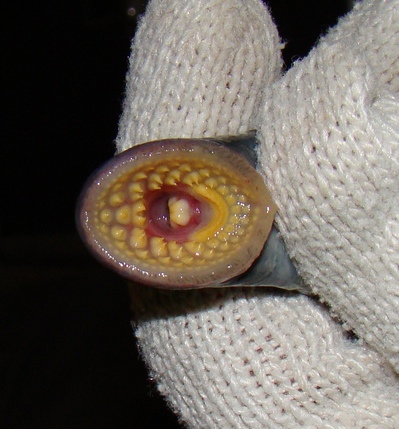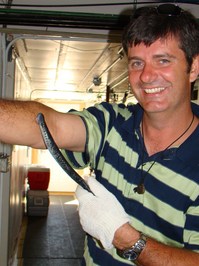How do you stop a sea lamprey invasion? Scientists are using sex as a weapon against this invasive species

Dr. Nick Johnson of the Sea Lamprey Biological Center.
Rick Taylor | Contributor
The Great Lakes are our most treasured natural resource in Michigan as I see it. Thankfully, many dedicated scientists also feel that way as well.
Russell Strach is the Director of the Great Lakes Science Center (GLSC) located right here in downtown Ann Arbor, Mich. The GLSC is a division of the United States Geological Center; otherwise known as USGS.
Russel informed me of their Sea Lamprey Biological Center on the shores of Lake Huron, just south of the Mackinaw Bridge. Dr. Roger Bergstedt was the director of this research facility until Dr. Nick Johnson took over as director earlier this year.
Well, it just so happened that our family was vacationing at Camp Michigania last summer a few miles from Petoskey. I had discussed the idea of making the short hour long drive to visit the sea lamprey research facility, and the kids loved the idea.
So, after a week of sailing, trap shooting, sand castles, archery and polishing Petoskey stones, our time at Camp Michigania was over. I packed up our luggage in my new Grand Cherokee and made our way to Hammond Bay on Lake Huron.
Johnson a veteran scientist who has spent seven years at the Hammond Bay Biological Center was waiting for us to show up. Poor Nick, he was waiting on a 9-year-old boy, 10-year-old boy, my pregnant fiancée and me — all on a Saturday morning.
Nick met us outside his sprawling facility, and we were taken back by the sheer beauty of this magnificent 64-acre research facility located on the shores of Lake Huron. This facility used to be a life saving station with the U.S. Coast Guard almost a century ago.
Nick explained that the waters here are difficult to navigate and the life saving station was essential to keeping sailors safe from the treacherous rocky shores. Thankfully, better maps became available of the lakes, making it safer for the sailors to navigate themselves away from the beautiful yet dangerous shores.
So, what is a sea lamprey and where do they come from? A sea lamprey is a parasitic fish that looks a lot like an eel but has the circular mouth with dozens of razor sharp teeth. They grow to about two feet long and feed off of other fish like Lake Trout, Whitefish and Salmon.

A sea lamprey's mouth.
Rick Taylor | Contributor
They literally swim up to one of these fish and anchor themselves on by suction. Then they’ll begin to sink their teeth into the flesh and suck on the blood until the fish dies or somehow gets away. Even the one’s who get away can die from infection or being too weak to feed or swim.
Sea lampreys come from the Atlantic Ocean and came in from shipping channels around Niagra Falls. Nick said it best in describing the problem with sea lampreys here in the Great Lakes: “A shark or other large ocean fish can survive a sea lamprey attack, but a small fish like the Lake Trout simply can’t.”
Nick’s sentiment is correct. The Great Lakes fisheries have been decimated by the invasion of the sea lamprey. They were first spotted in Lake Huron in 1936, and large numbers of them abounded in the 1940s, according to Nick.
The Great Lakes commercial fishing numbers plummeted so bad that the Hammond Bay Coast Guard facility was turned into the first sea lamprey research facility. It’s gone through a few name changes, but this facility is now run by the USGS.
Nick is literally on the front lines of fighting off the Sea Lamprey within the Great Lakes. He and others like him have dedicated their lives to saving our fish of the Great Lakes. But, it’s their research that has paid off in so many ways.
I always thought experiments were kind of boring in high school. But these guys make science look sexy! There’s a lot of truth in my comments. Nick and scientists like him have used sex as a weapon against the sea lamprey. And, with enough luck we may be able to manage, if not eliminate them in the Great Lakes altogether.
We need to understand the life cycle of the sea lamprey to exploit their weaknesses. I was shocked to learn that Sea Lampreys live a very long life; but not as an adult, like we would think. The adult female lays her eggs in a stream, river or creek, and they are immediately fertilized by the male.

Thankfully, the sea lamprey needs to aquire suction before burrowing its circular teeth into flesh.
They live in the larval stage for three to 13 years as an eyeless creature about the size of a night crawler worm. They live in the sand just as worms do for years and years until they finally get big enough to go out into the Great Lakes.
I was surprised to learn that the adult sea lamprey only lives for one year in the Great Lakes before returning to the spawning beds then dying right after. Just imagine how devastating they’d be if they lived for more than one year in the open waters.
Scientists were stumped at how the adult lampreys came back to where the larval lampreys were. It took years but they figured it out and this is truly amazing.
The eyeless and worm like baby lampreys were continually sending out pheromones downstream. The adult lampreys could smell the “sexy” call and headed upstream to their exact location and spawned. The scientists knew that they could raise baby lampreys in their research facility and “catch” the pheromones they produce. They could store and freeze the captured pheromones and use it at will to trick the lampreys into going somewhere else; perhaps a trap.
Scientists also began working on a sea lamprey repellant over the last couple of years. They found the best repellant to be a dead lamprey itself.
The scientists emulsified a lamprey (they would put a sea lamprey in a blender) and turn it into a puree, for lack of a better term. They found that live lamprey would scatter for cover at the slightest hint of that smell.
Now scientists had a repellant and an attractant. The scientists can use the repellant to keep sea lampreys from going upstream to a popular spawning bed. They could then use the attractant to lure them to a trap or infertile grounds.
This is science at its finest, and I’m humbled at their successes. This work is still in the experimental stage and scientists are currently using other methods to combat the growth of sea lampreys.
Two methods are currently being used. The first method is catching adult males in the spring and chemically sterilizing them (similar to chemotherapy) but not killing them.
The scientists would then release them into the St. Mary’s River and mate with the female. She has no idea that he can’t produce active sperm.
Another method involves the use of a poison that I can’t even pronounce which kills off the lampreys in the larval stage. Right now the USGS, U.S. Fish and Wildlife and the Canadian Department of Fisheries and Oceans (DFO) are working together.
Twenty streams have been selected; 10 in Canada and 10 in the U.S. These streams will be treated with the pheromones.
I’m excited to read about their successes in the near future in battling this invasive species. Feel free to read more about the research being done by going to www.usgs.gov.
Your comments and story ideas are warmly welcomed. Feel free to contact Rick Taylor at 734-223-5656 (cell) or by email at rtaylor@reinhartrealtors.com.


Comments
aawolve
Fri, Apr 1, 2011 : 2:05 p.m.
Fascinating article, keep up the good work Dr. Johnson and company.
Basic Bob
Fri, Apr 1, 2011 : 2:39 a.m.
I had horrible flashbacks to the Pat Benatar song.
Peter Jameson
Thu, Mar 31, 2011 : 8:46 p.m.
Tom jones says that you can use his "sex bomb" as a weapon against the lampreys if youd like.
David Briegel
Thu, Mar 31, 2011 : 6:50 p.m.
When I was in the Boy Sprouts we caught this ugly thing while smelt fishing near Oscoda. None of us new what it was until our Scout Master told us. We burned it in our campfire. Who knew how "sexy" they were? Good article and good writing. Now, they need to get ahead of the Asian Carp invasion! Any news on that front?
A2K
Thu, Mar 31, 2011 : 2:33 p.m.
Don't Sea Lamprey sell for $25/lb in Europe? I think they're a delicacy there...how about canning/freezing and shipping the buggers out that way, no limits! Or, is there an adventurous chef in the area? :O) Eating aside, very interesting article~
Epengar
Thu, Mar 31, 2011 : 6:59 p.m.
I think only a few places in Europe eat them, but it's a good idea. Unfortunately lampreys are feeding on large fish at the top of the food web, which means they could be getting exposed to high levels of pollutants (some chemicals get concentrated as you go up the food chain). Still worth investigating though.